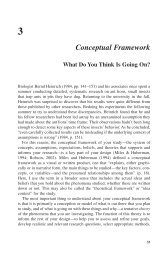Mixed Integer Linear Programming in Process Scheduling: Modeling ...
Mixed Integer Linear Programming in Process Scheduling: Modeling ...
Mixed Integer Linear Programming in Process Scheduling: Modeling ...
You also want an ePaper? Increase the reach of your titles
YUMPU automatically turns print PDFs into web optimized ePapers that Google loves.
138 FLOUDAS AND LIN<br />
where I j is the set of tasks that can be performed <strong>in</strong> unit ( j). Furthermore, if a task<br />
starts <strong>in</strong> a unit at a time <strong>in</strong>terval, no other task can start <strong>in</strong> the same unit until this task is<br />
f<strong>in</strong>ished. This requirement is enforced as follows:<br />
�<br />
i ′ ∈I j<br />
t+αij−1 �<br />
t ′ =t<br />
Wi ′ jt ′ − 1 ≤ M(1 − Wijt), ∀ j ∈ J, i ∈ I j, t ∈ T, (2)<br />
where αij is the fixed process<strong>in</strong>g time of task (i)<strong>in</strong>unit ( j) and M is a sufficiently large<br />
positive number.<br />
In addition to the b<strong>in</strong>ary variables, the follow<strong>in</strong>g two sets of cont<strong>in</strong>uous variables<br />
are also important. Bijt represents the amount of material which starts undergo<strong>in</strong>g task (i)<br />
<strong>in</strong> unit ( j)attime <strong>in</strong>terval (t) (i.e., batch-size), and Sst determ<strong>in</strong>es the amount of material<br />
state (s) dur<strong>in</strong>g time <strong>in</strong>terval (t). The batch-size of a task is related to the correspond<strong>in</strong>g<br />
assignment variable through the capacity constra<strong>in</strong>ts as follows:<br />
WijtV M<strong>in</strong><br />
ij<br />
i∈I p<br />
s<br />
j∈Ji<br />
≤ Bijt ≤ WijtV Max<br />
ij , ∀i ∈ I, j ∈ Ji, t ∈ T, (3)<br />
where V M<strong>in</strong><br />
ij and V Max<br />
ij are the m<strong>in</strong>imum and maximum capacity of unit ( j) for task<br />
(i), respectively. The mass balance can be expressed effectively by establish<strong>in</strong>g the<br />
relationships between the <strong>in</strong>ventory levels at two consecutive time <strong>in</strong>tervals through the<br />
follow<strong>in</strong>g constra<strong>in</strong>t:<br />
Sst = Ss,t−1 + �<br />
ρ p<br />
� �<br />
is Bi, j,t−αis − ρ c �<br />
is Bi, j,t + Rst − Dst, ∀s ∈ S, t ∈ T,<br />
(4)<br />
where I p<br />
s and I c s<br />
i∈I c s<br />
j∈Ji<br />
are the set of tasks that produce and consume state (s), respectively; ρ p<br />
is<br />
and ρ c is are the fractions of state (s) produced and consumed by task (i), respectively; Ji is<br />
the set of units suitable for task (i); αis is the process<strong>in</strong>g time for state (s)bytask (i). Rst<br />
is the amount of state (s) received from external sources at time <strong>in</strong>terval (t) and variable<br />
Dst represents the amount of state (s) delivered at time <strong>in</strong>terval (t). The restriction on<br />
storage of a material state is then represented simply as upper bounds on the variables<br />
Sst:<br />
0 ≤ Sst ≤ Cs, ∀s ∈ S, t ∈ T, (5)<br />
where Cs is the storage capacity limit for state (s).<br />
Other considerations, such as change-overs and limited utility resources, can also be<br />
<strong>in</strong>corporated readily <strong>in</strong> the discrete-time model (Kondili, Pantelides, and Sargent, 1988,<br />
1993). There has been subsequent progresses follow<strong>in</strong>g this discretization approach and<br />
discrete-time formulation and solution techniques have been developed for a variety<br />
of problems. Examples of related work <strong>in</strong>clude those presented by Pantelides (1993),<br />
Dedopoulos and Shah (1995), Pekny and Zentner (1993), Zentner et al. (1994), Bassett,<br />
Pekny, and Reklaitis (1996b) and Elkamel et al. (1997).
















